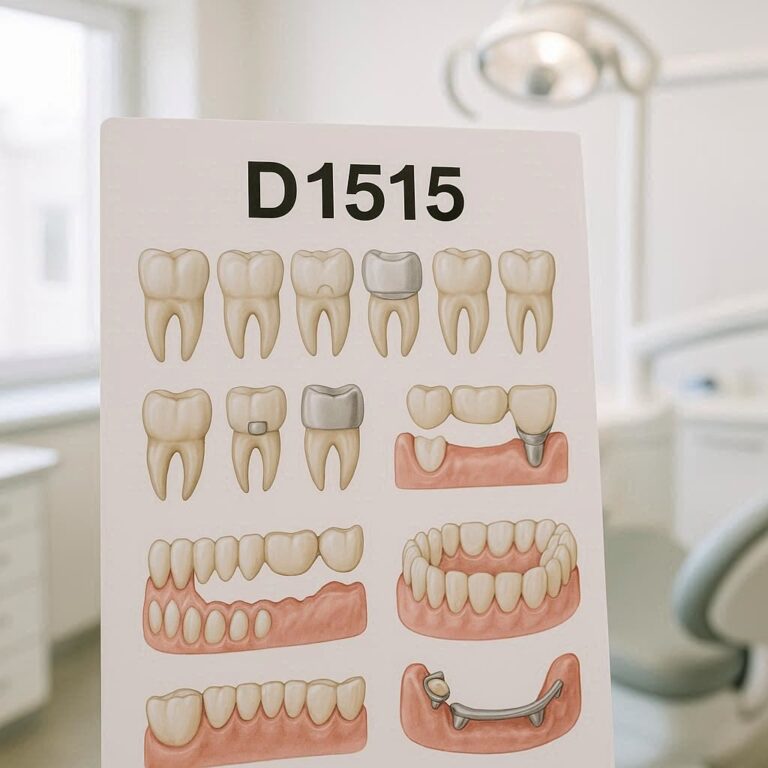D6058 Dental Code cost and Considerations
The dental code D6058 refers to the procedure for a single porcelain or ceramic crown, typically for a dental implant. This procedure is an essential part of restorative dentistry, aiming to replace a missing tooth with a durable, aesthetically pleasing crown that mimics the appearance and function of a natural tooth. Understanding the costs associated with D6058, the factors that influence these costs, and the procedure itself is crucial for patients considering this treatment. This article provides an in-depth exploration of the D6058 dental code cost, offering insights into its costs, factors affecting these costs, and what patients can expect throughout the process.

Understanding D6058: The Procedure
D6058 refers to a crown that is placed over an implant, typically made of porcelain or ceramic. This type of crown is designed to blend seamlessly with natural teeth, offering both durability and a natural appearance. The process involves several steps:
- Initial Consultation and Planning: The dentist conducts a thorough examination, which may include X-rays or 3D imaging to assess the patient’s oral health and determine the appropriate treatment plan.
- Implant Placement: The dental implant, usually made of titanium, is surgically placed into the jawbone. This serves as the root for the crown. The implant needs time to integrate with the bone, a process known as osseointegration, which can take several months.
- Abutment Placement: Once osseointegration is complete, an abutment is attached to the implant. The abutment acts as the connector between the implant and the crown.
- Crown Placement: Finally, the porcelain or ceramic crown (D6058) is placed onto the abutment. The crown is custom-made to match the color, size, and shape of the patient’s natural teeth.
Factors Influencing the Cost of D6058
The cost of D6058 can vary widely based on several factors. These include:
- Geographic Location: Dental procedures often cost more in urban areas or regions with a higher cost of living.
- Dentist’s Expertise: Experienced dentists or specialists may charge higher fees for their services.
- Material Used: The type of material used for the crown (porcelain, ceramic, etc.) can influence the cost. Porcelain and ceramic crowns are often preferred for their natural appearance but may be more expensive than other materials.
- Laboratory Costs: The cost of fabricating the crown in a dental laboratory can vary depending on the lab’s reputation, location, and the quality of materials used.
- Additional Procedures: If additional procedures are required, such as bone grafting or sinus lifting, these can add to the overall cost.
- Insurance Coverage: The extent of coverage provided by dental insurance can significantly affect out-of-pocket expenses. Some insurance plans may cover part of the cost, while others might not cover implant-related procedures at all.
Detailed Cost Breakdown
The cost of a D6058 procedure typically ranges from $1,500 to $3,500 per crown. However, this is a general estimate, and actual costs can vary. Below is a more detailed breakdown:
- Initial Consultation: $100 to $250
- Implant Placement: $1,000 to $3,000 per implant
- Abutment Placement: $500 to $1,000
- Crown (D6058): $1,500 to $3,500
Understanding the D6058 Dental Code
The D6058 dental code specifically refers to a “Porcelain/Ceramic Crown – Implant Abutment Supported.” This procedure involves placing a crown on an implant that has been surgically inserted into the jawbone. The crown is typically made from high-quality porcelain or ceramic materials, which are favored for their durability and ability to closely resemble the natural color and translucency of teeth.
The Importance of Porcelain/Ceramic Crowns
Porcelain and ceramic crowns are highly valued in restorative dentistry for several reasons:
- Aesthetic Appeal: These materials are chosen for their ability to blend seamlessly with natural teeth, providing a look that is both functional and visually pleasing.
- Durability: Porcelain and ceramic crowns are robust and resistant to wear, making them an excellent choice for long-term dental restoration.
- Biocompatibility: These materials are well-tolerated by the body, reducing the risk of allergic reactions or other complications.
The Cost of D6058: What Patients Should Expect
The cost of a D6058 procedure can vary significantly based on several factors, including geographic location, the expertise of the dentist, the materials used, and the specific needs of the patient. On average, patients can expect to pay between $1,500 to $3,000 per crown. However, this cost can fluctuate depending on various factors.
Factors Influencing the Cost of D6058
- Geographic Location: Dental costs often vary by region. Urban areas or regions with a higher cost of living tend to have higher dental fees compared to rural areas.
- Dentist’s Expertise: The experience and reputation of the dentist performing the procedure can significantly impact the cost. Highly skilled specialists may charge more for their services.
- Material Quality: The type of material used for the crown (porcelain vs. ceramic) can affect the price. Higher quality materials that offer better aesthetics and durability will usually come at a higher cost.
- Complexity of the Case: If the procedure requires additional work, such as bone grafting or complex implant placement, the overall cost will increase.
- Insurance Coverage: Dental insurance may cover part of the cost, particularly if the procedure is deemed medically necessary. However, the extent of coverage can vary widely depending on the insurance plan.
Detailed Breakdown of the D6058 Procedure
Initial Consultation and Examination
The first step in the D6058 procedure is an initial consultation with the dentist. During this visit, the dentist will conduct a thorough examination of the patient’s oral health, including X-rays and possibly a 3D scan of the jawbone. This helps in planning the placement of the implant and the design of the crown.
Implant Placement
Once the dentist has confirmed that the patient is a suitable candidate for a dental implant, the next step is the surgical placement of the implant. This titanium post is inserted into the jawbone and acts as a root for the crown. The procedure is typically done under local anesthesia, and the healing process can take several months, during which the implant fuses with the bone in a process called osseointegration.
Abutment Placement
After the implant has fully integrated with the jawbone, an abutment is attached to the implant. This piece serves as the connector between the implant and the crown. The gums are then allowed to heal around the abutment, which usually takes a few weeks.
Crown Placement
The final step in the D6058 procedure is the placement of the porcelain or ceramic crown. The dentist will ensure that the crown fits perfectly with the adjacent teeth and that the bite is correct. Once everything is in place, the crown is permanently attached to the abutment.
Advantages and Disadvantages of the D6058 Procedure
Advantages
- Natural Appearance: Porcelain and ceramic crowns closely resemble natural teeth, providing an excellent aesthetic outcome.
- Durability: With proper care, these crowns can last for many years.
- Functionality: The implant-supported crown restores full chewing ability, allowing patients to eat and speak without discomfort.
Disadvantages
- Cost: The procedure is expensive, and not all insurance plans cover it.
- Time-Consuming: The process can take several months from start to finish, requiring multiple visits to the dentist.
- Potential Complications: As with any surgical procedure, there are risks of infection, implant failure, or complications related to anesthesia.
Case Study: Patient Experience with D6058
Consider the experience of a patient, Sarah, who underwent the D6058 procedure after losing a tooth due to injury. Sarah’s journey began with a comprehensive consultation, followed by the surgical placement of the implant. Despite initial concerns about the surgery, Sarah found the procedure to be relatively painless, with a recovery period that was easier than expected.
The implant fused well with her jawbone, and a few months later, she received her porcelain crown. The final result was a tooth that looked and felt natural, allowing Sarah to regain her confidence and enjoy her favorite foods without hesitation.
Cost Comparison: D6058 Across Different Regions
To give a broader perspective on the costs, let’s compare the average prices of the D6058 procedure in different regions:
| Region | Average Cost (USD) |
|---|---|
| New York, USA | $2,500 – $3,500 |
| London, UK | £1,800 – £2,500 |
| Sydney, Australia | AUD 3,000 – AUD 4,000 |
| Toronto, Canada | CAD 2,200 – CAD 3,200 |
| Mumbai, India | INR 60,000 – INR 90,000 |
Insurance Considerations
Understanding your insurance coverage is crucial before undergoing the D6058 procedure. Many insurance plans categorize implant-supported crowns as a major restorative service, which may only be partially covered. It is essential to check with your provider to understand the specifics of your plan, including any out-of-pocket expenses.
Conclusion
The D6058 dental code represents a significant investment in dental health, offering a durable and aesthetically pleasing solution for replacing missing teeth. While the cost may be high, the benefits in terms of appearance, functionality, and long-term oral health are considerable. Patients considering this procedure should consult with their dentist to fully understand the costs, process, and potential outcomes.
FAQs
1. Is the D6058 procedure painful?
The procedure is typically performed under local anesthesia, so patients should not feel pain during the implant placement. Some discomfort may be experienced during recovery, but it can usually be managed with over-the-counter pain medication.
2. How long does the entire D6058 process take?
The entire process, from initial consultation to final crown placement, can take several months. The longest part of the process is the healing period after the implant placement, which can take three to six months.
3. Can the D6058 crown be replaced if it gets damaged?
Yes, if the crown becomes damaged, it can be replaced. However, this may incur additional costs, depending on the extent of the damage and whether it is covered by insurance.
4. What are the risks associated with the D6058 procedure?
Risks include infection, implant failure, nerve damage, and complications from anesthesia. However, these risks are relatively rare, and most patients experience successful outcomes.
5. Is the D6058 procedure covered by dental insurance?
Coverage varies by insurance plan. Some plans may cover part of the cost, particularly if the procedure is deemed medically necessary. It’s important to verify coverage with your insurance provider.


